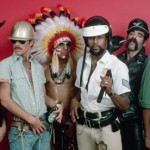Lenius, Steve. Life, Leather and the Pursuit of Happiness Nelson Borhek Press, 2010 Google books
Lenius’ book is a collection of columns published in Lavender magazine since 1995. It covers a considerable swath of recent history, including the rise of the Internet as a mass medium and some of the most politically and sexually tumultuous events.
His 1999 visit to Erotica ’99 trade show, right next to the Gay & Lesbian Business Expo, in NYC: “Erotica was kinky but very hetero, while the Gay & Lesbian Business Expo was very gay but not terribly kinky. I found myself wishing for a combination of the two.” Having attended several Taboo trade shows in Vancouver, I can attest that sex trade shows tend to be very un-queer.
In his column on people who build fucking machines, he observes that the people who build these devices are all men and apparently heterosexual. One could argue that women (whether by nature or nurture) are less inclined to find technological solutions to problems, while heterosexual men tend to think of sexual performance with women as a duty to be fulfilled and a problem to solve.
My particular interest was in the historical sections. Lenius views WWII as a turning point for gay identity. “… the rough-and-tumble, almost-hypermasculine comradeship of their military days held a romantic and even a sexual attraction.” (Pg.55) There was a strong blue-collar theme to this culture. You didn’t “play with” someone, you “worked on” or “got worked on by” someone. Implements were “tools,” not “toys.” The recognition phrase was “Are you a working man?” This ties into the view of the working-class as a source of masculine authenticity, much like the military. This was an exclusively male culture, no lesbians or straights allowed. In the 1980s, leatherwomen formed a similar culture, and AIDS brought leather men and women together. Leatherwomen started taking care of ailing men and raising money for research.
Heterosexuals don’t enter Lenius’ narrative until the early 90s, after leathermen have become visible to the mainstream. Then they start coming out of the closet and talking with leathermen, creating the possibility of a pansexual leather community. That was published in 2001, and I’m not sure that has really come to pass. This account also glosses over the organized hetero kink community that goes back to the early 1970s.
Lenius also talks about Robert Bienvenu’s work on BDSM history, comparing the “soft” images of 19th century kink (silk, lace, fur, etc.) with the “hard” images of 20th century kink (leather, latex and metal, etc.) Beivenu’s American fetish style began in the 1930s as an offshoot from the European fetish style, while Gay Leather developed in isolation from either style in the 1950s.
Other columns document the “cleaning up” of New York and San Francisco in post-2000 years; the decline of leather magazines like Drummer, surpassed by the Internet; brief histories of the Leather Archive and Museum; issues of race and age among leathermen; the hankie code (said to have started in the Gold Rush of 1849, creating a nearly all-male society in which men who would lead during dancing would wear bandanas in the left pocket, while the “girls” wore them in the right pocket); the controversy over leather dress codes (again returning to the theme of military/working class masculinity by barring polo shorts and loafers); and how the AIDS crisis transformed pageant winners from pretty title-holders to ambassadors and fund-raisers.
There’s also some particular insights into the differences and similarities between gay, lesbian and straight BDSM culture. Scene names, for example, are rarities in gay male and lesbian circles, while straights who use their real names in the Scene are the minority. I suspect that this has something to do with Internet culture’s influence on the straight BDSM culture, in which handles were commonplace, both for anonymity and for a heightened sense of initiation. Another aspect is the greater acceptance of alcohol and other substances in gay BDSM play, likely due to the centrality of bars in leather culture. “The unspoken but implicit message often seems to be that drinking and drugs are integral parts of the scene, necessary elements of machismo; if you don’t partake, maybe you’re not a real leatherman or leatherwoman.” (Pg.226)
Thankfully, since Lenius wrote that in 1997, there are many more non-bar social events for leatherfolk, and pansexual events tend to be dry.
Lenius writes mainly from the gay leatherman perspective. He’s particularly engaging when he writes about his personal experiences: coming out twice, living with his family, his life in leather bar culture, his experiences as a leather pageant judge. He’s also aimed at a gay but not necessarily kinky readership via the magazine, so some of it is more written as outreach for the curious vanilla gay man and woman. This is a bit frustrating, as I get the impression that Lenius could go much deeper into various topics, but his regular column format and his vanilla readership forces him to stay on the surface. His column predates blogging as a mainstream medium, which might have better served him to explore ideas in more depth.



